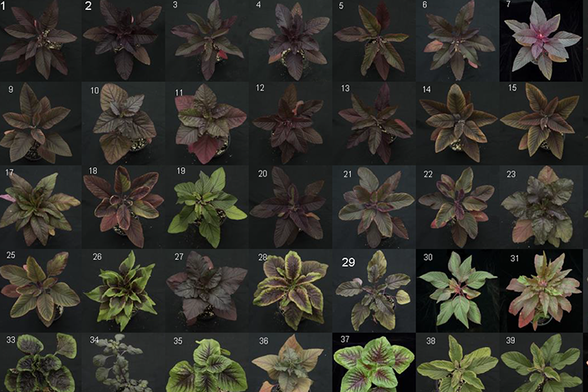Want a natural food dye? Amaranth delivers, according to Illinois study

URBANA, Ill. – Artificial food dyes have been linked to multiple health concerns, including hyperactivity in children, allergies, and certain cancers. The science isn’t settled and the Food and Drug Administration says color additives are safe, but consumers are nonetheless clamoring for natural alternatives.
Recent University of Illinois research shows amaranth plants are a good source of red pigments called betalains, which could be used in a wider variety of food applications than other plant-derived pigments. The study, published in Frontiers in Plant Science, quantified betalain content in 48 amaranth varieties, providing the food industry with multiple promising candidates for future product development.
“Our paper serves as a global survey of vegetable amaranth to determine the diversity in hue, concentration, and chemical structure of magenta-red color compounds. It also provides methodology for accurate and high-throughput color quantification. This information builds a strong basis for additional work to investigate commercial scale-up and color performance in food applications,” says lead author Jay Howard, who completed the study as a master’s student in the College of Agricultural, Consumer and Environmental Sciences (ACES) at U of I. Howard is now applications manager at Kalsec Inc.
The researchers selected four dozen amaranth varieties from the USDA National Plant Germplasm System, representing a full spectrum of foliage coloration from deep burgundy to lime green. They grew the plants in a greenhouse and extracted pigments from stem and leaf tissue using a simple water method, in accordance with FDA guidelines. Then they fed the extracts through lab equipment to discover which betalain pigments were most prevalent.
“We developed a chemical profile for each extract, looking at the ratio of dominant pigments. Some of the minor components, which are co-extracted in the water method, may contribute to the color and stability of the main pigments. These properties are very interesting for food companies, because you might get a very bright pink or red color, but then if it fades to brown after a day, it’s useless. We found that, for some of our plants, the extracts were stable over days or even weeks. We’re planning to follow up with more research on that,” says study co-author Chance Riggins, research assistant professor in the Department of Crop Sciences at ACES.
Most food companies currently source betalains as a co-product from red beet production, but Riggins says beet-derived pigments have some drawbacks.
“Beets are off-putting for some people. Those earthy flavor compounds often get transferred in a basic betalain extract. So, food companies are really open to natural food colorants from alternative sources and doing it in a way that could extend applications for different food products,” he says.
The researchers did a basic taste and color test by mixing up a Kool-Aid-type concoction with their amaranth extracts. “A few were slightly reminiscent of beets, but mostly we couldn’t smell or taste anything,” Riggins says.
For a few amaranth varieties in the study, the betalain extracts appeared bluer than the bright reds from beets. With further research, the unique color could fill a gap in the available portfolio of natural colorants.
Another plus? Amaranths are famously tough and can grow in less-than-pristine conditions. Betalains, along with anthocyanins and other pigments, allow amaranths to handle environmental stress, acting as antioxidants and repairing cellular damage due to drought, heat, or intense solar exposure. But the researchers don’t expect amaranth plantations to start popping up on weedy roadsides across the U.S., at least not solely for betalain production.
“I don't think amaranth is ever going to be a crop strictly grown for pigmentation; there aren't many crops like that. But amaranth is already approved by the FDA for food use, and under those guidelines could be approved as a natural food colorant,” Riggins says. “Amaranth is mainly grown commercially for the seeds, often for gluten-free applications, but there's a lot of biomass wasted from the seed harvest. Our data suggests the pigment could be a value-added product down the line.”
Howard adds, “The shift from synthetic ingredients requires a diverse toolkit of natural options so that the food industry can match the color hue and stability of synthetic colors at an effective cost-in-use. Amaranth is an exciting crop that addresses each of these points — it is a scalable, resilient, antioxidant-rich crop with impressive biomass yields. Unlike red beets, the current sole commercial source of betalains, vegetable amaranth also provides green chlorophylls and yellow carotenoids that provide additional hues. These added byproducts enable lower costs and greater sustainability.”
The study extends a longstanding research theme in the College of ACES that investigates natural food compounds as colorants and health promoters. For example, as an undergraduate, Howard got involved in the purple corn project to identify rich sources of anthocyanin pigments in purple and blue corn varieties. College faculty, especially those in the Department of Food Science and Human Nutrition and the Division of Nutritional Sciences, are also actively pursuing bioactive compounds for human health.
The article, “Amaranth as a natural food colorant source: Survey of germplasm and optimization of extraction methods for betalain pigments,” is published in Frontiers in Plant Science [DOI: 10.3389/fpls.2022.932440]. Authors include Howard, Riggins, and Maria Villamil. The project was funded in part by the USDA’s Agriculture and Food Research Initiative and the College of ACES.